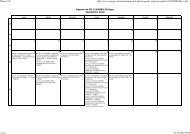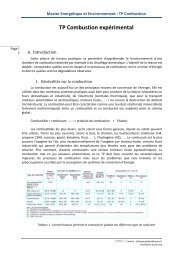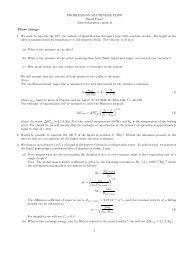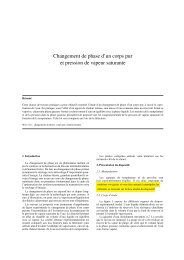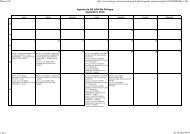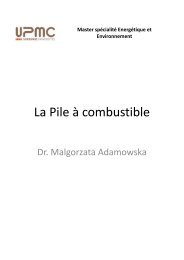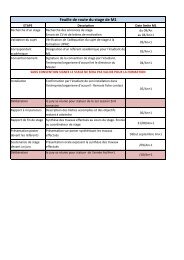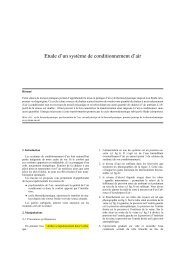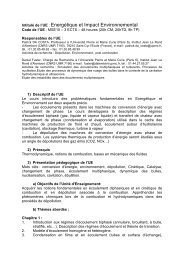Vibrations et ondes - Master 2 en Mécanique des fluides et ...
Vibrations et ondes - Master 2 en Mécanique des fluides et ...
Vibrations et ondes - Master 2 en Mécanique des fluides et ...
You also want an ePaper? Increase the reach of your titles
YUMPU automatically turns print PDFs into web optimized ePapers that Google loves.
<strong>Vibrations</strong> <strong>et</strong> <strong>on<strong>des</strong></strong><br />
Descriptif<br />
Code d’UE<br />
Type d’UE<br />
Tronc commun<br />
Volumes horaires globaux (CM + TD + TP+ autre…) CM : 20 TD : 20 TP : 20<br />
Nombre de crédits de l’UE 6<br />
Spécialité où l’UE est proposée<br />
toutes<br />
Semestre où l’<strong>en</strong>seignem<strong>en</strong>t est proposé<br />
S1<br />
Effectifs prévus (r<strong>en</strong>trée 2009) 160<br />
Organisation pédagogique<br />
Enseignem<strong>en</strong>ts prés<strong>en</strong>tiels Volume horaire total Horaire hebdomadaire Effectif/groupe<br />
Cours 20 2 80<br />
Enseignem<strong>en</strong>ts dirigés 20 2 24<br />
Travaux pratiques 20 4 12<br />
Proj<strong>et</strong><br />
Autre<br />
Objectifs de l'Unité d'Enseignem<strong>en</strong>t<br />
L'objectif de ce cours est de montrer les concepts de base relatifs à l'étude <strong>des</strong> vibrations mécaniques <strong>des</strong><br />
systèmes discr<strong>et</strong>s <strong>et</strong> continus. Une seconde partie s'intéresse aux phénomènes propagatifs dans les flui<strong>des</strong> <strong>et</strong><br />
soli<strong>des</strong>, leur intéraction avec les vibrations <strong>des</strong> structures ainsi qu’une introduction à l’intéraction flui<strong>des</strong>tructure<br />
à travers d’exemples.<br />
Cont<strong>en</strong>u de l’Unité d’Enseignem<strong>en</strong>t<br />
Partie vibration :<br />
- Systèmes vibrants linéaires à n degrés de liberté (ddl) : systèmes conservatifs à n ddl, réponse modale<br />
du système libre, réponse sous excitations harmonique, périodique, transitoire, quelconque ;<br />
résonances; systèmes dissipatifs, réponse à une excitation quelconque, résonance amortie. Analyse<br />
<strong>et</strong> id<strong>en</strong>tification modale<br />
- Milieux continus : On<strong>des</strong> stationnaires, Influ<strong>en</strong>ce <strong>des</strong> conditions aux limites;<br />
o Milieux unidim<strong>en</strong>sionnels dans les cor<strong>des</strong>, de traction-compression dans les poutres<br />
droites, de torsion dans les arbres, de flexion dans les poutres droite<br />
o Milieux bidim<strong>en</strong>sionnels : On<strong>des</strong> dans les membranes, Vibration de flexion <strong>des</strong> plaques<br />
planes , Réponse impulsionnelle <strong>et</strong> réponse <strong>en</strong> fréqu<strong>en</strong>ce, Excitation ponctuelle <strong>et</strong><br />
répartie, Déformées modales <strong>et</strong> opérationnelles<br />
- Métho<strong>des</strong> approchées :<br />
o Réduction à 1 ddl : Méthode de Rayleigh,<br />
o Réduction à 2-3 ddl: Méthode de Rayleigh-Ritz,<br />
o Introduction aux élém<strong>en</strong>ts finis
Partie <strong>on<strong>des</strong></strong> :<br />
- équations de propagation dans les grands systèmes physiques relevant de mécanique,<br />
- étude de principaux phénomènes physiques associés à la propagation (réflexion-transmission,<br />
dispersion, atténuation)<br />
- Plusieurs exemples <strong>et</strong> applications : exemples de base dans lesquelles les couplages vibration <strong>et</strong><br />
<strong>on<strong>des</strong></strong> apparaiss<strong>en</strong>t ; exemples de couplage fluide-structure, où l’onde qui se propage dans le fluide<br />
est couplée à une vibration d’un solide ; autres applications : intéraction houle avec une plate-forme<br />
pétrolière ; bruit dans l’habitacle d’une voiture (parois rayonnantes) ; vibrations d’origine sismique ;<br />
<strong>et</strong>c.<br />
Pré-requis<br />
Système compl<strong>et</strong> à 1 degré de liberté, système à deux degrés de liberté : notion de couplage,<br />
introduction aux systèmes à n degrés de liberté sans amortissem<strong>en</strong>t.<br />
Modalités de contrôle <strong>des</strong> Connaissances<br />
Exam<strong>en</strong>s répartis 70% TP 30%<br />
Référ<strong>en</strong>ces bibliographiques<br />
- JL Guyader : Vibration de milieux continus Hermes<br />
- Géradin, Michel ; Rix<strong>en</strong>, Daniel, "Théorie <strong>des</strong> vibrations : application à la dynamique <strong>des</strong> structures",<br />
Masson<br />
- François Axisa "Modélisation <strong>des</strong> systèmes mécaniques" Vol1 Système discr<strong>et</strong>s Vol 2 Systèmes<br />
continus, Hermès<br />
- C. Lesueur : Rayonnem<strong>en</strong>t acoustique <strong>des</strong> structures, Eyrolles<br />
- H.J.-P. Morand, R. Ohayon : Intéractions fluide-structure, Lavoisier<br />
- M. Bruneau : Introduction aux théories de l’acoustique, Univ. Du Maine<br />
Rédacteurs (principaux, 3 maxi) de l’UE<br />
Nom, Prénom, qualité Faverjon Béatrice, MCF Régnier Stéphane, Pr<br />
Laboratoire ou équipe de<br />
Institut <strong>des</strong> Systèmes<br />
LMT Cachan<br />
recherche<br />
Intellig<strong>en</strong>ts <strong>et</strong> de Robotique<br />
Adresse<br />
61 av. du Présid<strong>en</strong>t Wilson<br />
94230 CACHAN<br />
4 Place Jussieu<br />
75252 Paris Cedex<br />
Téléphone : 01 47 40 53 01 01 46 54 88 17<br />
e-mail: faverjon@lmt.<strong>en</strong>s-cachan.fr stephane.regnier@upmc.fr<br />
Course Title : <strong>Vibrations</strong> and waves<br />
Description of the course :<br />
Objective<br />
The aim of the course is to show first the basic concepts of the mechanical vibrations of discr<strong>et</strong> and<br />
continuous systems. The second part of the course deals with the wave propagation in fluid and solid<br />
media, their interaction with the linear vibrations of structures, an introduction to the fluid-structure<br />
interaction with several examples.<br />
Cont<strong>en</strong>t
Vibration part :<br />
<strong>Vibrations</strong> of discr<strong>et</strong> linear systems of n degrees of freedom (DOF) ; with and without damping ; modal response for a<br />
free system ; responses under differ<strong>en</strong>t types of excitations : harmonic, periodical, transi<strong>en</strong>t, <strong>et</strong>c ; resonnances ;<br />
Modal analysis and id<strong>en</strong>tification.<br />
- Continuous media : standing waves, influ<strong>en</strong>ce of the boundary conditions.<br />
o One-dim<strong>en</strong>sional media : strings, longitudinal waves in beams, torsional waves in rotors, b<strong>en</strong>ding waves in<br />
beams.<br />
o Two-dim<strong>en</strong>sional media : Membrane waves, b<strong>en</strong>ding vibrations of plates, Impulse response and frequ<strong>en</strong>cy<br />
response, Located and distributed excitation, Modal and operational deformations.<br />
- Approximate m<strong>et</strong>hods :<br />
o Reduction to 1 DOF : Rayleigh m<strong>et</strong>hod,<br />
o Reduction to 2-3 DOF: Rayleigh-Ritz m<strong>et</strong>hod,<br />
o Introduction to the finite elem<strong>en</strong>t m<strong>et</strong>hod<br />
Wave part :<br />
- Equations of wave propagation in usual mechanical systems,<br />
- study of major wave propagation physical ph<strong>en</strong>om<strong>en</strong>a (reflexion-transmission, dispersion, att<strong>en</strong>uation)<br />
- Many examples and applications : basic examples showing the coupling b<strong>et</strong>we<strong>en</strong> vibrations and wave<br />
propagation ; examples of the fluide-structure interaction in which the wave propagating in the fluid is coupled<br />
to a vibration of the structure ; other applications : interaction of the swell with an oil platform houle, noise in a<br />
cockpit of car : radiant walls, vibrations seismic origin ; <strong>et</strong>c.<br />
Prerequisites<br />
One degree of freedom system compl<strong>et</strong>e study, concepts for the coupling in a two-degrees of freedom<br />
system, in a n-degrees of freedom system without damping.




